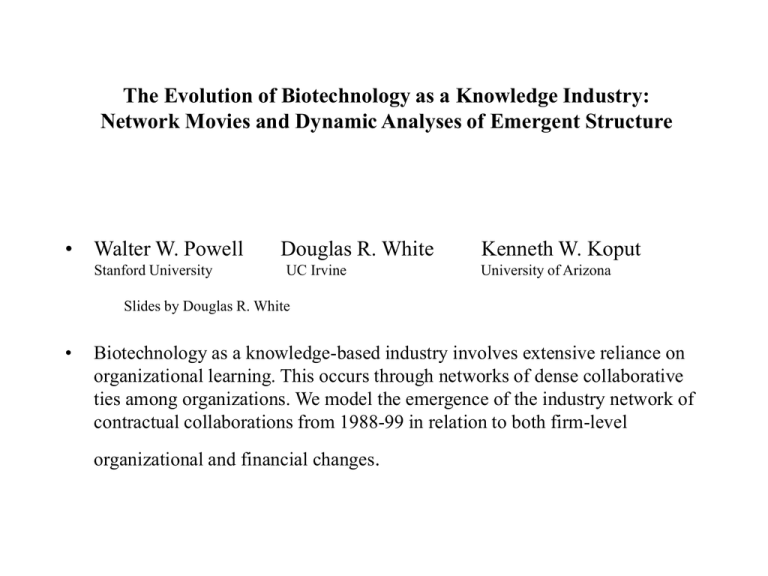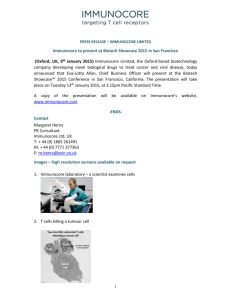The Evolution of Biotechnology as a Knowledge Industry:
advertisement

The Evolution of Biotechnology as a Knowledge Industry: Network Movies and Dynamic Analyses of Emergent Structure • Walter W. Powell Stanford University Douglas R. White UC Irvine Kenneth W. Koput University of Arizona Slides by Douglas R. White • Biotechnology as a knowledge-based industry involves extensive reliance on organizational learning. This occurs through networks of dense collaborative ties among organizations. We model the emergence of the industry network of contractual collaborations from 1988-99 in relation to both firm-level organizational and financial changes. Network Movie: 1988-99 • The following twelve slides show the evolution of collaborative contracts within the biotech industry • Green ties =Finance • Red ties =Res&Dev » » » » » » Grey LiteBlue Yellow Orange DarkBrown Pink =Finance =Biotech =Pharmaceuticals =Res.Labs and Universities =Government (e.g., NIH) =Miscellaneous 1988: Lots of Finance, little R&D 1989: Nucleus of R&D attracts more Finance 1990: Massive investment in R&D 1991: The phase transition is complete 1992: …and then it stops 1993: 1994: 1995: 1996: 1997: 1998: 1999: Figure 1: Levels of Network Cohesion: Tricomponents (within dark/red circles) embedded in Bicomponents (circled in medium/green) within Components (in light/yellow circles) Figure 2: Slow Transitions to Giant Components, 1990-1994 1800 1600 1400 1-comp 1200 1-mode 1000 482edges 800 edges 600 2-mode 3112edges 400 200 0 1983 1985 1987 1989 1991 1993 1995 1997 1999 Figure 3: Rapid Phase Transition in Bicomponent Growth 700 600 R&D 500 Lic 400 300 Finance 200 Comm 100 R&D/Lic /Com edge frq 0 1988 1990 1992 1994 1996 1998 Figure 4: Degree(+1) Distributions for the 1-Mode Data 1000 frequency 100 10 1 1 DBF degree 10 (482 biotech firms) 100 Figure 5 a: Degree(+1) Distributions for the 2-Mode Data # Organizations 10000 1000 482dbf 100 partners 10 1 1 10 # Links (plus 1) 100 Figure 5 b : Degree(+1) Distributions for the 2-Mode Data (removing zero frequency counts) # Organizations 10000 1000 482dbf 100 partners 10 1 1 10 # Links (plus 1) 100 Figure 5 c: Exponential for DBFs' degree choosing partners; power-law for partners degree chosen by DBFs 10000 1000 482dbf partners 100 dbf*.85 part^0.9 10 1 0 5 10 15 20 25 30 35 Figure 6: Scatterplot of Biotech degree as chosen by other Biotechs (1-Mode) and as chosers of 2-Mode Partners (v2log=.55+0.52v1og; R-Square=0.15) Degree Correlation for Biotech Firms 2-m ode 100 10 1 1 10 1-m ode 100 Figure 7: The Sexta-component of R&D and Finance Contracts in the Biotech Industry Blue=Biotech, Size of nodes reflects number of finance ties. Brown=government Orange=Research Institutes and Universities Yellow=Pharmaceuticals (f=DBF p=partners) Figure 7: The Sexta-component of R&D and Finance Contracts in the Biotech Industry Blue=Biotech, Size of nodes reflects number of finance ties. Brown=government Orange=Research Institutes and Universities Yellow=Pharmaceuticals (f=DBF p=partners) Figure 8: 1988 Figure 8: 1989 Figure 8: 1990 Figure 8: 1991 Figure G1: Time Series of Growth Parameters: Mean Growth by Tie Activity, Separately for Form of Partners. 0.12 0.25 0.1 0.2 0.08 0.15 0.06 0.1 0.04 0.05 0.02 0 0 -0.02 -0.05 -0.04 -0.1 1 2 3 4 5 6 7 8 9 10 11 -0.06 0.12 0.4 0.1 0.35 1 2 3 4 5 6 7 8 9 10 11 1 2 3 4 5 6 7 8 9 10 11 0.3 0.08 0.25 0.06 0.2 0.04 0.15 0.02 0.1 0 0.05 -0.02 0 -0.04 -0.05 1 2 3 4 5 6 7 8 9 10 11 0.25 0.2 0.15 0.1 0.05 0 -0.05 -0.1 1 2 3 4 5 6 7 8 9 10 11 Figure G2: Time Series of Growth Parameters: Mean Growth by Partner Form, Separately for Type of Activity. 0.4 0.25 0.35 0.2 0.3 0.15 0.25 0.1 0.2 0.05 0.15 0.1 0 0.05 -0.05 -0.1 0 1 2 3 4 5 6 7 8 9 10 11 0.12 -0.05 1 2 3 4 9 8 7 6 5 10 11 0.25 0.1 0.2 0.08 0.15 0.06 0.1 0.04 0.05 0.02 0 0 -0.02 -0.05 -0.04 1 2 3 4 5 6 7 8 9 10 11 -0.1 1 2 3 4 5 6 7 8 9 10 11 Figure G2: Time Series of Growth Parameters: Mean Growth by Partner Form, Separately for Type of Activity. 0.4 0.25 0.35 0.2 0.3 0.15 0.25 0.1 0.2 0.05 0.15 0.1 0 0.05 -0.05 -0.1 0 1 2 3 4 5 6 7 8 9 10 11 0.12 -0.05 1 2 3 4 9 8 7 6 5 10 11 0.25 0.1 0.2 0.08 0.15 0.06 0.1 0.04 0.05 0.02 0 0 -0.02 -0.05 -0.04 1 2 3 4 5 6 7 8 9 10 11 -0.1 1 2 3 4 5 6 7 8 9 10 11 Figure G1: Time Series of Growth Parameters: Mean Growth by Tie Activity, Separately for Form of Partners. 300 100 250 50 200 0 150 100 -50 50 -100 0 -50 1 2 3 4 5 6 7 8 9 10 11 -150 1 2 3 4 5 6 7 8 9 10 11 • Left Figure Plots Coefficient of Variation over time for Modal Combinations: Magenta = R&D to Universities and NonProfits, Red = R&D to Government, Green= Finance to Financial, Cyan = Commercial to Biotech, Blue = Commercial to Pharmaceutical and Other For- Profit. • Right Figure Plots Coefficient of Variation for all remaining combinations with no color legend. Figure 9: Cycles of Learning and Organizational Returns (Powell et al. 1999) Legend 1. Ovals represent network properties, rectangles are performance and outcome measures, while rounded rectangles can be treated as either firm characteristics or outcomes. 2. Shadowed components carry over from Powell et al. (1996). Figure 10 a: Finance and R&D networks of 2219 organizations 1988-1991 Figure 10 b: Finance and R&D networks of 2219 organizations 1992-1995 Figure 10 c: Finance and R&D networks of 2219 organizations 1996-1999 Figure 11: Distance from NIH: R&D and Finance




